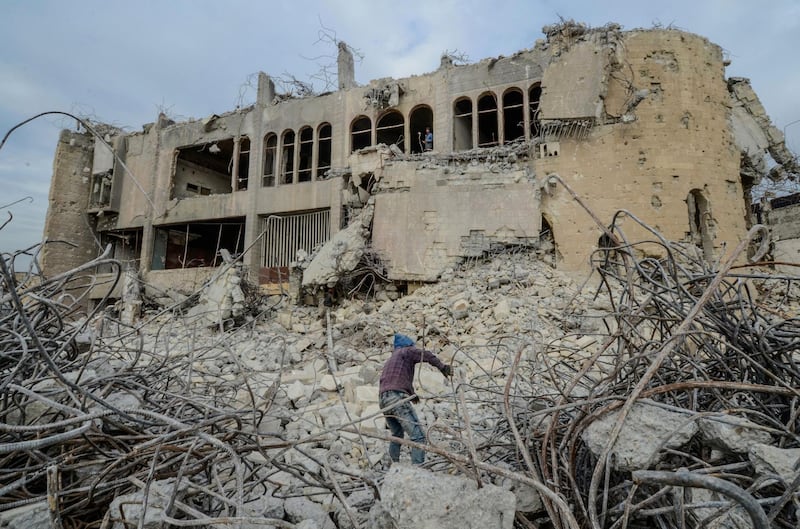Only three floors remain of Mosul’s National Insurance Company building, where ISIS killed young men it accused of homosexuality and breaking Islamic law.
While Unesco and Iraqi religious leaders last month laid the cornerstone to rebuild the northern Iraqi city’s famous Al Nuri Mosque and adjacent leaning minaret, other buildings were being torn down.
Demolition work on the National Insurance building began about a month ago, tearing down the remains of one of Mosul’s most important buildings.
Built in 1966 and designed by Iraqi architect Rifat Chadirji, the structure was an example of modern Iraqi design.
It had rows of slim archways and projected windows reminiscent of Iraq’s famous shanasheel, a style common in homes close to water.
Mr Chadirji has been called the father of Iraqi architecture and is also credited with notable buildings in Baghdad as well as more than 100 homes and monuments across the country.
His projects include the Tobacco Monopoly Headquarters and the Central Post Office in Baghdad.
_______________
Read more:
Car bomb kills six and wounds 30 near Iraq's Mosul
How eliminating the ‘kill box’ turned Mosul into a meat-grinder
Iraqis are living among a hidden arsenal that could explode
ISIS claims deadly Iraq attack only days after Trump says group has been defeated
_______________
But in 2017 the insurers’ building was ravaged by the months-long fight to remove ISIS from Mosul.
After the city’s liberation, returning residents were confronted with the wrecked skeleton of a building that had long towered over them.
For some, the seven-storey structure stopped being a symbol of the optimism and development in Iraq. Twisted rebar pierced ceilings and walls, and mounds of rubble were everywhere.
The image of a group of men being blindfolded and led up a set of staircases before plummeting to their death remains vivid.
“It’s a terrifying sight,” Mosul resident Samira Ali said. “It reminds me of the death penalty Daesh would mete out against innocent people by throwing them off the roof.”
But not all Moslawis agree with her.
“My feelings are gloomy and sad it is a part of our history, life and future,” photographer Saad Haadi told The National. “The very old buildings in the city are art.”
Abu Mahmud, 33, said: “The relevant authorities should have kept it this way, as a witness to the ugliness of Daesh’s crimes against Mosul.”
Architecture historian Dr Caecilia Pieri recently told US magazine Architect that the building could become “a landmark of resistance against ISIS oppression”.
“It is understandable that they want to get rid of this past, but this building was designed by Rifat Chadirji, who not only was an opponent of the Baathist regime but was once jailed for his political stance,” Dr Pieri said.
Mr Chadirji, an important cultural figure between the 1950s and 1970s, was jailed for 20 months during former dictator Saddam Hussein’s rule.
Ms Pieri compared Mosul with Lebanon’s buildings damaged by years of war.
“I’m not here to judge,” she wrote in an open letter. “I’m just here to remind of the example of southern Lebanon, to show you that other ways of resilience do exist.”
But Moslawi architect Ghada Rzouki thinks her city has other architectural gems worth preserving. “I was born in Mosul,” Ms Rzouki said.
“In my view, there are many other religious and heritage sites that no one is paying attention to but which should be protected," she said.
Another local official told AFP that a new government building would likely be erected on the same plot of land but that there had been no plans to set up a memorial to victims of ISIS crimes there.
The NIC building lies near Mosul's Old City, which was badly damaged by fighting and where the UN's heritage agency Unesco is carrying out restoration work.
"A committee was formed to study the building and assessed it was no longer viable, and that any restoration at this stage would be futile," Mohammad Jassem, a municipal official representing Mosul's nearby Old City, said.
He said discussions were ongoing to demolish other buildings damaged in the fighting, including Mosul's branch of the central bank and the Nineveh governorate.






